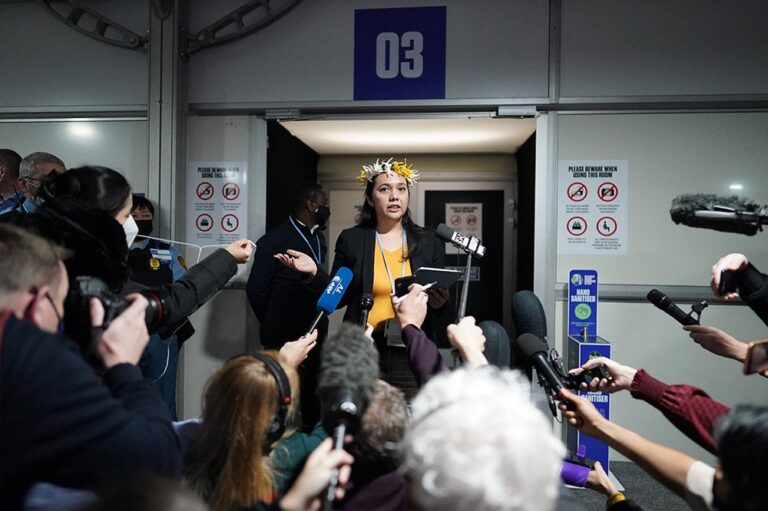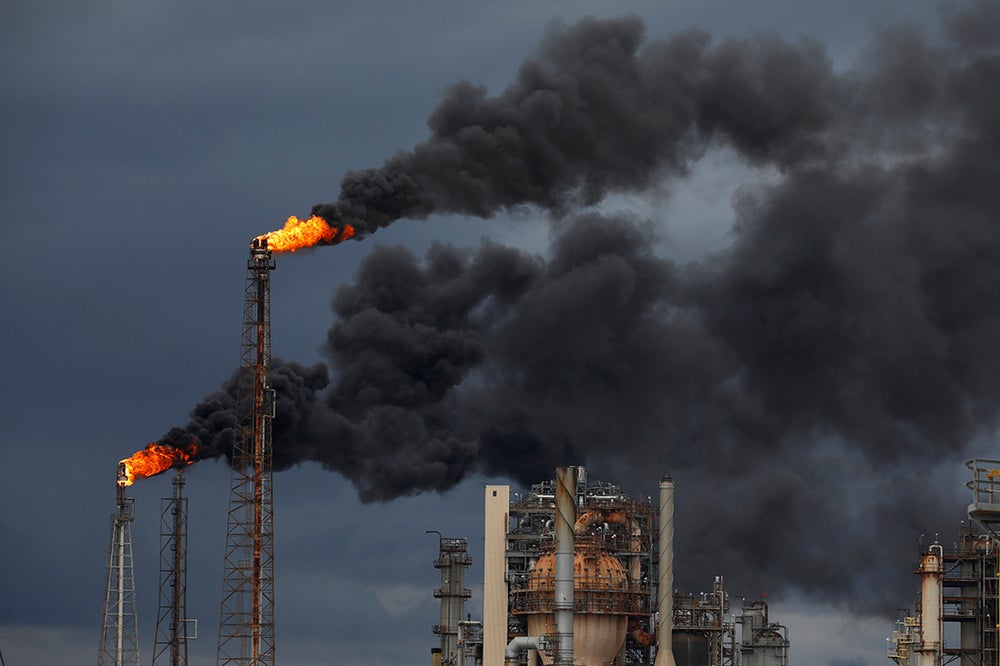
[ad_1]
Imagine you started a fire in your neighborhood, down the street from your house. You didn’t mean to—you’re no arsonist—but there it is, blazing before your eyes. Your neighbor’s house is about to go up in flames. What do you do?
There is only one answer, of course: You try to put it out. You run over with buckets and hoses. You do everything you can to be useful. As long as there is a chance of saving your neighbor’s home, no matter how small, you keep working. After all, you started it. You should be the very last person to surrender.
What you don’t do is sit and watch the destruction from the relative safety of your home. You don’t try to convince people that the losses won’t be all that bad. And you definitely don’t start shouting at your neighbors to give up—that trying to put out the fire is not realistic.
This is the situation we face as the world gathers in Dubai for COP 28. Our climate is hurtling toward 1.5 degrees Celsius of heating over preindustrial levels. One recent study estimates that if emissions continue apace, we have a 50 percent chance of reaching a global annual average of 1.5 degrees C in just six years. But as we approach this grim milestone, we still have choices. Those of us who live in the “West” or the “Global North” (two geographically dubious terms that essentially mean wealthy, powerful nations) have the greatest responsibility for igniting the blaze that now threatens the entire neighborhood. So will we run toward the fire, determined to help? Or will we set up lawn chairs and watch it burn?
Unfortunately, much of the current discourse around 1.5 degrees C reflects the second choice. Instead of action, we’re increasingly obsessed with prognostication: Will we, or won’t we, hold global average temperature rise to 1.5 degrees C? From there, it’s a short leap to a narrative of surrender: if we’re going to breach 1.5 C anyway, maybe we should just give up trying. We’re relating to the climate crisis as if it’s something we’re watching instead of something we’re doing—and that mindset has enormous consequences.
“People do not realize the implications this has for quite a large majority of the world’s population,” says Adelle Thomas, a senior fellow at the University of the Bahamas and vice chair of Intergovernmental Panel on Climate Change Working Group II, which focuses on climate change impacts and adaptation. I met Thomas in 2021, when I was preparing to report at COP 26, the U.N. climate talks in Glasgow, Scotland. A few months before the conference, we met online for a quick check-in. As soon as her face flickered into view, I knew something was wrong.
“How are you doing?” I asked.
“Well, not great,” she said. “It looks like everyone’s just abandoning 1.5 C.” In the wake of another somber emissions assessment, the message that 1.5 C was out of reach was circulating in the media and online. “They’re saying we should focus on more ‘realistic’ goals, like 2 degrees C. Or who knows, maybe even higher!” she said, shaking her head. “It’s insane.”
Thomas knows just how insane. As one of the lead authors of the 2018 IPCC Special Report on 1.5 degrees C, she helped to catalog the catastrophes that await us if we allow temperatures to rise 2 degrees C above preindustrial levels. Among many takeaways: hundreds of millions more people will regularly be exposed to severe heat waves, crucial crops will fail much more frequently, and the majority of coral reefs will die. We don’t have to wait to get to 1.5 C to understand the risks; we can simply look around at the floods, fires and famines happening now. This is life at 1.2 degrees C of warming. Now picture it getting a whole lot worse.
Global heating is like turning the knob on a stove, not flipping a light switch; if we hit 1.6 degrees C, we don’t suddenly wake up to an utterly changed world. But the 1.5 C report made clear that the journey up the thermometer to that point—let alone beyond it—will be chaotic and destructive, with ever-increasing risks of triggering climate tipping points that could send us into devastation. No one knows exactly where those tipping points are, and that’s why we need to proceed with caution. We have nothing to gain and everything to lose by finding out.

“‘One-point-five to stay alive’ is reality, it’s not a slogan,” Thomas says.
But it’s a reality that powerful nations long resisted. Prior to the landmark U.N. climate conference in Paris in 2015, the big emitters had de facto agreed that 2 degrees C (3.6 degrees F) was an acceptable limit to global temperature rise. For years, people from developing countries pushed back, saying that although wealthier nations might be able to survive that level of climate chaos, they could not. Most of these countries had (and have) very low emissions but very high levels of climate risk. They did little to cause the climate crisis, but they’re feeling the impacts first and worst.
In Paris, people from island states, least-developed countries and other nations coalesced around a campaign of “1.5 C to stay alive.” Thomas was there. In public protests and backroom conversations they pushed, pleaded and pressured the major emitters, especially the U.S. and China, to get 1.5 degrees C into the final text.
The battle ended with a half victory. The stated goal of the Paris Agreement is holding global temperature rise to “well below 2 degrees C above preindustrial levels” and “pursuing efforts to limit the temperature increase to 1.5 degrees C.” When that line was read into the record on the last day of the conference, a huge cheer erupted in the crowd. “Pursuing efforts” wasn’t perfect, but it was something.
Sadly, that statement has not translated into nearly enough action. Some progress has been made—especially in the build-out of renewables—but emissions and temperatures are still rising.
It’s worth pausing for a moment to appreciate how different the climate conversation would be if it weren’t for the people who fought relentlessly for 1.5 degrees C. Without their efforts, that number likely wouldn’t have made it into the Paris Agreement, and could have easily faded from public consciousness. This would have made the world much more dangerous for everyone. By insisting on protection for people in the most climate-vulnerable nations, the “1.5 C to stay alive” campaigners were protecting us all. As Tina Stege, climate envoy for the Marshall Islands, said in a steely voice at the 2021 COP 26 meeting, “One-point-five is nonnegotiable. The safety of my children—and yours—hangs in the balance.”
But instead of being celebrated for focusing the world’s attention on 1.5 C, Stege, Thomas and others are repeatedly being made to defend their position. When I checked in with Thomas a few months ago, she told me it was “extremely depressing” to see headlines declaring “The 1.5-Degree Goal Is All But Dead,” (the Atlantic, April 2022) or telling the world to “say goodbye” to 1.5 C because “it’s time for some realism” (the Economist, November 2022). “It’s a very privileged and dismissive message, and incredibly frustrating,” she says. “It’s like gaslighting.”
This perspective does intend to communicate the seriousness of our situation, but it also implies that there are two teams—those who are stuck in a fairy tale that we can hold temperature rise to 1.5 degrees C, and people who are willing to face the hard truth. This is a fundamental misunderstanding. Thomas and others are not in denial about how small our window of opportunity for avoiding runaway heating has become. They’re looking at the same data as the self-appointed realists, but drawing a different conclusion about how to respond: instead of giving up on 1.5 C, they believe we need to redouble our efforts toward it. This is not because they’re deluding themselves, but because they know every tenth of a degree of additional warming sentences more people to death.
From Thomas’s perspective, the people admonishing others to “get real” about 1.5 degrees C are the ones who are seriously out of touch with climate realities. “I think they are coming from their particular perspective of privilege, where they are not in the midst of climate impacts and are not seeing climate change as an existential threat,” she says. Thomas doesn’t need anyone to tell her how to think about 1.5 C. She needs the world to listen, and to act.
“One-point-five is a truly globally catastrophic threshold. Anybody who says we need to just give up on it is talking through their hat,” said Saleemul Huq, former director of the International Center for Climate Change and Development and former professor at the Independent University Bangladesh. “We just simply cannot give up on it.”
When Huq died suddenly in October from a heart attack, a long-revered voice was lost. He had attended every COP meeting since they began in 1995, serving as an advisor to the Climate Vulnerable Forum and other groups. He said when people talk about giving up on 1.5 C, one of the most important questions to ask is “Who’s giving up?” No one in the groups he was working with was entertaining that idea. “You do not hear it from the Global South,” he said.
As Thomas also noted, Huq said the narrative of surrender on 1.5 C comes almost exclusively from people living in wealthy nations, who are not personally feeling threatened by the climate crisis. “It’s not for them to say we have to give up,” Huq said. “Who the hell are they?”
This is a powerful question that everyone with some amount of protection from climate chaos should ask ourselves. People on the front lines of this crisis have made their position clear: 1.5 degrees C is the maximum level of suffering that their communities can withstand. Who am I to say otherwise? What right do I have to tell anyone to surrender their hopes for a livable home, for the preservation of their history, culture and future? What entitles me to decide what level of destruction is “realistic” for someone else to accept, especially while I enjoy the benefits of living in a nation that has dumped more carbon pollution into the atmosphere than any other?

For Eric Njuguna, a Kenyan climate activist, talk of abandoning 1.5 C is “a stab in the back…. It’s self-centered, and it’s screwing the lives of many.” Njuguna says that expecting developing countries to tolerate even more burden is outrageous. “Right now here in Kenya, there is an ongoing drought that has put millions of people at severe risk of hunger,” he says, “and it’s only going to get tougher from here. We cannot afford to go above 1.5 degrees C. It’s going to be devastating, especially for African countries.”
The narrative of surrender is “morally irresponsible,” adds Michai Robertson, a lead climate negotiator for the Alliance of Small Island States. Like Huq, Robertson believes it is essential to ask who is giving up. Anyone who claims that 1.5 C is dead, he says, has an obligation to ask—and try to answer—who killed it. “Then we can talk about identifying the perpetrator, finding the cause, and then figuring out how to fix the problem. There is accountability there.”
For people who are used to looking at climate issues through an exclusively technical lens, talk of privilege and accountability, perpetrators and responsibility may be startling. But there is more than one way to think about 1.5 degrees C, because it is more than one thing. Scientifically, 1.5 C is fully in the danger zone. Historically, it’s a hard-won promise. Politically, it’s a rallying cry. Morally, it’s a deep obligation that major emitters owe to the rest of the world; indeed, it is the lowest rung on the ladder of climate ethics, the first step on the long journey of taking responsibility for the damage done.
None of these definitions of 1.5 degrees C are sufficient on their own; we need an integrated understanding. And then we need to act.
So what should we do? Everything we can, as quickly as we can, for as long as it takes. No matter where the global thermometer eventually maxes out, the actions we need to take now are the same: stop emitting planet-warming gasses, preserve and protect whatever we can, and help each other adapt. The wealthy world needs to follow the lead of people in the most climate-vulnerable places and adopt a “never surrender” mentality, rallying around aggressive climate action as if our lives depend on it—because they do.
As we do that work, we can be heartened by the fact that none of our actions are wasted, even if we do breach 1.5 C. All kinds of things matter in relation to that threshold—not just whether we pass it, but the speed of our approach, how long we linger near it, and if we do go past, how fast and how far. The more we can slow temperature rise, the more time we have to prepare for impacts, and the better chance we have of lowering the peak. Hitting 1.5 degrees C in 2060 is a much less deadly scenario than hitting it in 2030. The same goes for hovering at or above 1.5 C versus rocketing up to 2 C or beyond. These differences will be measured in a mind-boggling number of dollars, species extinctions and human lives.
Coral reefs are just one example. The IPCC estimates that at 2 degrees C, 99 percent of coral reefs will be lost. But if we can hold warming to 1.5 C, between 10 percent and 30 percent of reefs may be saved. Neither of those outcomes is happy; the difference is between frightening levels of destruction and annihilation. But such differences matter, not only for corals, polar bears and ice sheets, but for human communities everywhere. Every tenth of a degree of heating we prevent means more lives saved, more destruction avoided, more species that manage to make it through.
Furthermore, “If you were to exceed 1.5 C degrees warming, the case for ambitious action is strengthened rather than weakened,” says Jim Skea, current chair of the IPCC. That’s because 1.5 C was never the finish line; it is (hopefully) the turnaround point. Human civilization depends on a stable climate, and to achieve that we have to stop the heating, and then bend the temperature curve back down. As environmental scientist Johan Rockström tweeted in 2022: “I just get tired…Tired of hearing that 1.5°C is a ‘target’ or ‘goal’. IT IS NOT. It is a limit. The only real goal is zero degrees Celsius.”
This is why declarations that 1.5 C is dead make no sense. Global temperature limits don’t die if we surpass them. People do.
In 2022 the IPCC stated that it was “almost inevitable that we will temporarily exceed [the 1.5 degrees C] temperature threshold but could return to below it by the end of the century,” with carbon removal from the atmosphere and other drawdown techniques. In the fall of 2023 the International Energy Association released its latest Net Zero Roadmap, which framed the future slightly more optimistically, saying that there is a “narrow but feasible” possibility of holding warming to 1.5 C. More reports will come, and we should read them, even if (especially if) the information they deliver is terrifying. But we should use that information as motivation, not as an excuse to blithely write off the effort to save millions of lives.
This is the power of the “never surrender” paradigm; it can help us find agency within this overwhelming crisis. When it’s clear that it’s your home, your community, your life on the line, you act. You don’t ask “What are the chances?” but rather “How can I help?” You don’t just pursue effort—you find it. And that effort does some good, even if it isn’t enough.
As dire as our situation appears to be today, in the future, we’ll look back and see people who had choices. No one will care about what we thought we could or couldn’t do; all that will matter is what we actually did. Working relentlessly to limit global temperature rise to 1.5 degrees C—even if we temporarily surpass it—is choosing to reduce suffering for people and life on the planet as a whole. It’s hard to imagine any scenario in which that is not the right thing to do.
This is an opinion and analysis article, and the views expressed by the author are not necessarily those of Scientific American.
[ad_2]